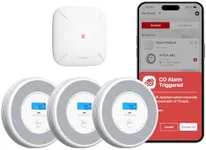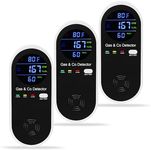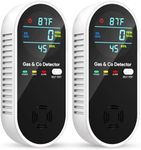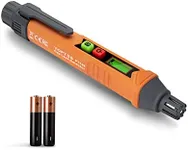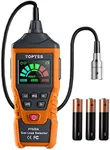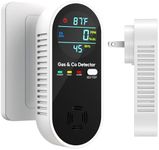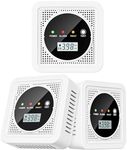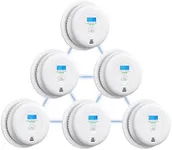Buying Guide for the Best Home Gas Detector
Choosing the right home gas detector is crucial for ensuring the safety of your household. Gas detectors can alert you to the presence of dangerous gases, such as carbon monoxide, natural gas, or propane, which can be harmful or even fatal if undetected. When selecting a gas detector, it's important to consider several key specifications to ensure you get the best fit for your needs. Understanding these specifications will help you make an informed decision and provide peace of mind for you and your family.Type of Gas DetectedThis specification indicates which gases the detector can sense. Common gases include carbon monoxide (CO), natural gas (methane), and propane. It's important because different gases pose different risks and may be present in different areas of your home. If you have gas appliances, a detector for natural gas and propane is essential. For homes with fireplaces or attached garages, a carbon monoxide detector is crucial. Choose a detector based on the specific gases you need to monitor in your home.
Sensor TechnologySensor technology refers to the method the detector uses to sense gas. Common types include electrochemical sensors, metal oxide semiconductor sensors, and catalytic bead sensors. This is important because it affects the detector's sensitivity and reliability. Electrochemical sensors are highly accurate for detecting carbon monoxide, while metal oxide semiconductor sensors are good for detecting combustible gases like methane and propane. Catalytic bead sensors are also used for combustible gases but are less common in home detectors. Choose a sensor technology that matches the type of gas you need to detect and the level of accuracy you require.
Power SourceThe power source of a gas detector can be battery-operated, plug-in, or hardwired. This is important because it affects the installation process and the detector's reliability during power outages. Battery-operated detectors are easy to install and can continue to function during a power outage, but they require regular battery replacement. Plug-in detectors are convenient and don't require battery changes, but they won't work during a power outage unless they have a battery backup. Hardwired detectors are the most reliable but require professional installation. Choose a power source based on your preference for installation ease and reliability during power outages.
Alarm TypeThe alarm type refers to how the detector alerts you to the presence of gas. Common alarm types include audible alarms, visual alarms (flashing lights), and digital displays. This is important because it affects how quickly and effectively you can respond to a gas leak. Audible alarms are loud and can wake you up if a leak occurs at night. Visual alarms are useful for the hearing impaired or in noisy environments. Digital displays provide real-time gas concentration levels, which can be helpful for monitoring. Choose an alarm type that ensures you will be promptly and effectively alerted to any gas leaks.
Placement and Coverage AreaPlacement and coverage area refer to where the detector should be installed and how much area it can effectively monitor. This is important because proper placement ensures the detector can accurately sense gas leaks. Detectors should be placed near potential sources of gas leaks, such as gas appliances, fireplaces, and garages. The coverage area varies by model, so it's important to choose a detector that can cover the size of the room or area where it will be installed. Consider the layout of your home and the locations of potential gas sources when choosing a detector with the appropriate coverage area.
Additional FeaturesAdditional features can include things like interconnectivity with other detectors, smart home integration, and self-testing capabilities. These features are important because they can enhance the functionality and convenience of the detector. Interconnectivity allows multiple detectors to communicate with each other, providing broader coverage and ensuring that an alarm in one area triggers alarms in other areas. Smart home integration allows you to receive alerts on your smartphone and control the detector remotely. Self-testing capabilities ensure the detector is functioning properly without manual testing. Choose additional features based on your preferences for convenience and enhanced safety.
